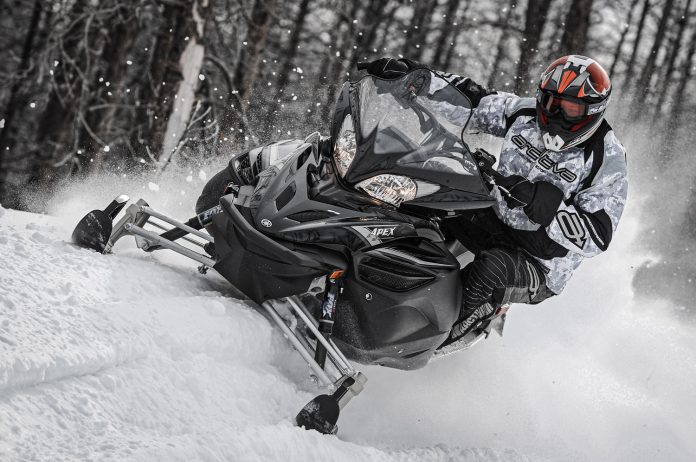Ah yes. A question for the ages! There’s been a ton of emails, comments and texts from viewers and readers who still have a love affair going with this incredible snowmobile engine.
Of course, the 998cc turbocharged SideWinder has replaced the 998cc 4-cylinder Apex now as Yamaha’s flagship performance sled. Doesn’t matter though.
More than a few Yamaha aficionados would still slap down deposits for an SR with that Genesis 4 under the hood.
Although we’re not sure that particular twin cam 16-valver would even fit inside the bodywork of an SR, there are a lot of other reasons why Yamaha won’t likely revive that engine. Here are a few of our insights (for what they’re worth):
Weight:
There are a lot of parts whizzing around in this 4-cylinder – actually, almost 25-percent more than in the 998cc triple. They all add weight. Even with a turbocharger, the triple comes very close to the old Apex Genesis in weight. Turbocharge the four? Not likely.
Complexity:
The Apex’s engine was an icon of complexity able to deliver peak power in the 12,000 RPM range and still live forever. Someone had to machine all those wristwatch-like components and ensure they were properly sourced, heat-treated and toleranced so the engine would perform and stay together.
No simple feat – and a credit to Yamaha’s engine-building prowess. The SideWinder’s 998cc triple is flat-out simpler to build and, when boosted, easily surpasses the Genesis 4’s power output – with reliability.
Also, the old Genesis 4 had a geared driveshaft connected to the primary clutch to gear down the engine’s extremely high engine RPM so the clutch rotated at about 8,500 and didn’t evaporate clutch parts. The 998 triple doesn’t need this technology.
Cost to Build:
See item #2.
Width:
Because of its I-4 configuration, the Genesis 4 would be very difficult to package into any of the current SR platforms Yamaha is using. Exhaust routing of four header pipes would also require some complex engineering tweaks. Still possible, but why do it?
Handling:
The gyroscopic effect of a 4-cylinder engine spinning out even mid-range RPM is stronger than a triple or twin (The gyro effect makes the sled want to continue in a straight line instead of turning precisely in corners while resisting turn-in at the skis). Add in the weight factor and, even with good skis like Yamaha’s Strykes, you’ve got an engineering challenge to make it handle like a SideWinder.
Conclusions:
It makes more sense to offer a dumbed-down SideWinder turbo package making, say, 145 to 160 ponies. Yamaha wouldn’t necessarily need an intercooler on an engine in this range and its pricing, although potentially lower than the current SideWinder, would attract customers who wanted a sled in the Apex’s power range. Think marketing. A sled like this may also fit Yamaha’s future plans for a new SR-II chassis – if one is coming someday.
So, we just don’t think a revival of the Genesis 4 is likely. Yeah, we’re sad about it, too. We can still hear that jewel-like quad-cylinder at full cry down old Kevlar Lake. Even at idle its 4-pipe sound could make you drool.
Yamaha has walked away from a lot of great, trend setting engineering before and broken our hearts (DI 2-strokes, EXUP Exhaust to name a couple). Oh well, at least we got EPS back again this year!








